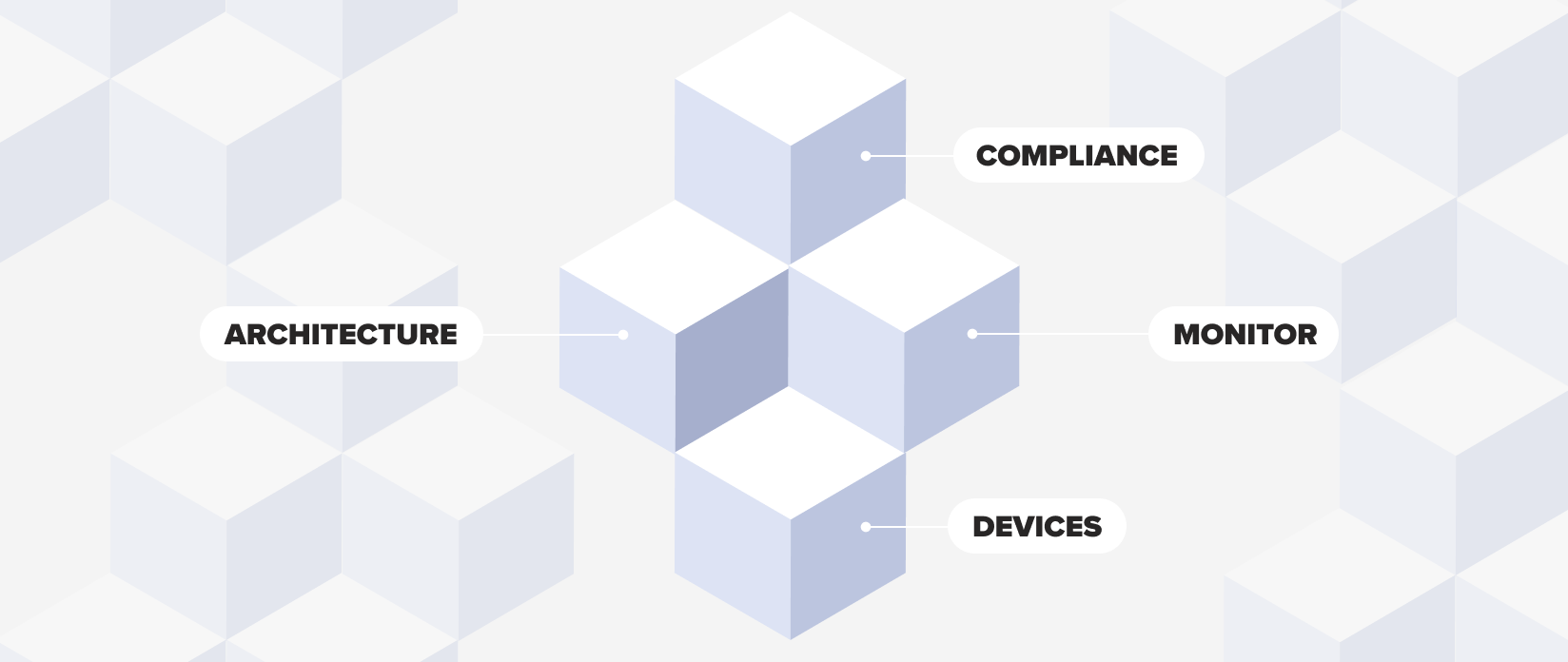
Secure Industrial IoT Networks: Best Practices and Strategies
The stakes for industrial systems are high. Unlike traditional IT systems, industrial IoT (IIoT) environments control physical processes. One breach can cause downtime, damage equipment, or jeopardize safety. As cyber threats become more sophisticated, securing IIoT networks is a strategic imperative. But securing these environments isn't always easy.
Protecting IIoT starts with a proactive plan. We'll share that and more in this article:
- Layer-by-layer IIoT security strategies
- Real-world tips to reduce risks and improve efficiency
- Expert advice on compliance and staying ahead of cyber threats


IIOT
Interconnected systems in industrial settings. Devices, sensors, and machines work together, sharing data to improve processes, efficiency, and decision-making.
IOT
The broader network of interconnected devices (smart home gadgets, wearables, and consumer electronics) that enhance daily life.

Unique security challenges
Legacy Systems
Many industrial environments still use decades-old equipment not designed with cybersecurity in mind.
Real-Time Constraints
IIoT systems often require deterministic, real-time performance, limiting the use of traditional security tools that introduce latency or jitter.
Physical Exposure
Devices are often deployed in remote or unsecured locations (factory floors, pipelines, substations), making them vulnerable to physical tampering or sabotage.
Heterogeneity
IIoT ecosystems have a wide range of devices, operating systems, and communication protocols from vendors, complicating standardization and integration.
5 building blocks of IIoT security

A robust IIoT security strategy embraces a defense-in-depth model, addressing protections at every layer — from devices in the field to cloud services that aggregate IIoT data.
Architecture
|
Purdue model
|
Network segmentation
|
Zero trust architecture
|
Secure gateways
|
|---|
Many organizations use the Purdue model, which divides control systems into hierarchical levels or zones (like sensors, control devices, supervisory systems, and the enterprise network) to enable segmentation.
Network segmentation isolates OT systems from IT and internet-facing networks, preventing breaches and lateral movement. Be sure to put a demilitarized zone (DMZ) in between.
All of this is enforced with zero trust architecture (ZTA), which assumes no trust within the network. Every connection is verified for identity, context, and compliance.
You may need secure gateways for your layered IIoT architecture. For example, IoT edge gateways in the DMZ manage communication between OT devices and cloud services.
Devices
|
Secure boot/hardware root of trust
|
Certificate-based authentication
|
Firmware integrity and updates
|
Trusted platform modules
|
|---|
All your IIoT devices should be secure from the ground up. Use secure boot to prevent firmware tampering. Establish a hardware root of trust to verify the device's identity and integrity.
Certificate-based authentication is a best practice and confirms a device's identity. Each device gets a unique private key and X.509 certificate to prove who it is when connecting to networks or cloud services.
Firmware integrity and updates are important. IIoT devices should only run authorized codes. Code signing ensures companies cryptographically sign updates before installing updates.
Secure boot checks the software during startup to ensure it hasn’t been tampered with. If something is wrong, it stops the device from starting. Since many industrial devices have been used for a long time, you need to update your security and software easily, ideally over-the-air and with little downtime.
As for physical device security? Some devices have trusted platform modules (TPMs), and vaults for storing keys and ensuring the device’s state hasn’t been compromised.
Networks
|
Encrypt and authenticate
|
Replace or wrap legacy protocols
|
Link-layer encryption
|
Avoid man-in-the-middle attacks
|
|---|
Data moving through an IIoT network — whether between devices, to a gateway, or the cloud — needs to be protected in transit. Simple, plain-text protocols (like Modbus) don't have enough security.
To protect your data, encrypt and authenticate all communication between devices. We recommend secure methods like MQTT over TLS, secured OPC UA, and HTTPS because they balance speed and safety.
You may need to replace or wrap legacy protocols when upgrading to secure protocols.
For example, use OPC UA (OLE for process control unified architecture) over TLS instead of a legacy Modbus link.
Inside industrial facilities, tools like IPSec VPNs or MACsec protect data (link-layer encryption) as it moves. Any time data leaves a secure zone, such as moving from a sensor to an aggregation server, it should go through an encrypted channel. You'll lower the risk of man-in-the-middle attacks and breaches.
Monitor
|
Intrusion detection and protection
|
Security and event management
|
Passive network monitoring
|
AI-driven anomaly detection
|
|---|
You need tools to spot problems, like intrusions or unusual behavior, in real time. This calls for specialized intrusion detection and prevention systems (IDS/IPS), along with constant monitoring, tailored to industrial protocols.
All data and alerts from edge devices and IDS/IPS sensors should feed into a central security information and event management (SIEM) for analysis. Modern SIEM platforms process IoT/OT telemetry alongside IT logs. This allows cross-domain threat hunting and incident response.
It identifies all IIoT/OT devices on the network and flags vulnerabilities like outdated firmware or open ports. Using behavioral analytics and threat intelligence, they detect anomalies. Passive network monitoring ensures no disruption to sensitive equipment.
If you want to quickly find unusual activity, consider AI-based anomaly detection.
Lastly, you should prepare an incident response playbook with IoT scenarios. IIoT incidents are different from IT incidents. You might need to immediately stop the production line, rather than just isolate the server.
Compliance
|
ISA/IEC 62443
|
NIST SP 800-82
|
NIS2 Directive
|
EU Cyber Resilience Act
|
|---|---|---|---|
Building a secure IIoT environment isn’t just technical. You'll also need to meet industry standards and comply with cybersecurity regulations.
By following established security frameworks, you'll manage risks and meet customer and regulator expectations.
In the industrial world, the ISA/IEC 62443 standards give a detailed framework to help you secure automation and control systems. They cover everything from product development for manufacturers to system design for integrators and security processes for asset owners.
NIST SP 800-82 (now the Guide to Operational Technology Security) helps you assess risks, apply security controls, and handle incidents.
If you’re operating in critical sectors in the EU, the NIS2 Directive (adopted in 2022) requires you to follow stricter cybersecurity rules. You’ll need to implement better risk management, report major incidents within 24 hours, and improve supply chain security for IIoT and OT systems.
If you manufacture IoT devices, you should prepare for the upcoming EU Cyber Resilience Act (CRA). This will introduce baseline security rules for digital products, including security by design, regular updates, and clear vulnerability policies.
Top strategies for IIoT success
To keep up with everything, you should take a proactive and strategic approach to IIoT security. Drawing from current best practices and future trends, here are some tips for any enterprise starting or advancing its IIoT journey:

Use multiple layers of security: Protect every part of the system, like devices, networks, apps, and the cloud. Don’t just rely on one security measure.

Choose secure devices: When buying or building IIoT devices, make sure they meet high-security standards, such as IEC 62443.

Make devices and networks stronger: Turn on features like secure boot and authentication. Disable anything you don’t need (like unused ports), use strong encryption, and assume hackers will try to attack — so prepare for it.

Monitor everything: Keep an eye on the system all the time and make sure it’s part of your security team’s routine.

Follow standards and train your team: Use well-known security guidelines (like IEC 62443 or NIST) to check for weaknesses and train staff to handle these systems effectively.
If you embed security into every layer and keep up with trends, you will unlock the full potential of digital transformation — safely and sustainably.
Start a conversation with us
